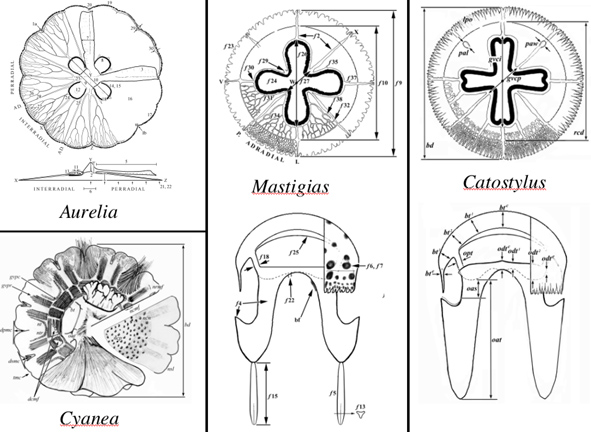Morphometrics
on medusae
Michael N Dawson

Quantitative morphometrics of scyphomedusae have, to date, been used primarily for comparisons of populations within species and of species within genera. It is evident from the images aggregated above that many of these measurements may also be used for distinguishing species in different genera, families, and orders of Scyphozoa. Such usage would dovetail with the traditional character-based morphological approach to systematics.
As quantitative morphometric measurements are made on more species, the range and number of features measured will increase over the few sets used so far (see above), in which case presence-absence data on characters, as well as quantitative measurements of character states will become more important in comparisons across higher taxa. This will then parallel the approach currently employed in statistical phylogenetics.
One of the key benefits of quantitative morphometric analyses is that there is a standardized approach to making a specific set of measurements. This allows anybody anywhere to statistically compare taxa and to get the same objective results..
More detailed information describing quantitative morphometric and statistical phylogenetic analyses of medusae, as well as references to some of the relevant literature, can be found in the following citations.
Bolton, T.F., & W.M. Graham (2004) Morphological variation among populations of an invasive jellyfish. Mar. Ecol. Prog. Ser. 278:125-139.
Dawson, M.N (2003) Macro-morphological variation among cryptic species of the moon jellyfish Aurelia (Cnidaria: Scyphozoa). Mar. Biol. 143:369-379.
Dawson, M.N (2005) Morphological variation and systematics in the Scyphozoa: Mastigias (Rhizostomeae, Mastigiidae) - a golden unstandard? Hydrobiologia 537:185-206.
Dawson, M.N (2005) Five new subspecies of Mastigias (Scyphozoa: Rhizostomeae: Mastigiidae) from marine lakes, Palau, Micronesia. J. Mar. Biol. Assoc. UK 85:679-694.
Dawson, M.N (2005) Morphologic and molecular redescription of Catostylus mosaicus conservativus (Scyphozoa: Rhizostomeae: Catostylidae) from south-east Australia. J. Mar. Biol. Assoc. UK 85:723-731.
Gershwin, L.-A., & A.G. Collins (2002) A preliminary phylogeny of Pelagiidae (Cnidaria, Scyphozoa), with new observations of Chrysaora colorata comb. nov. J. Nat. Hist. 36:127-148.
Marques, A.C., & A.G. Collins (2004) Cladistic analysis of Medusozoa and cnidarian evolution. Invert. BIol. 123:23-42.